Soils in the Shawnigan Lake Watershed — More Questions
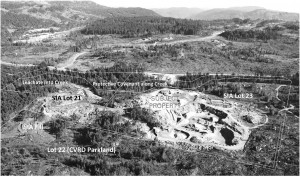 Back in April I wrote a piece on the wisdom of dumping contaminated soils in the Shawnigan Lake watershed. I visited the region with Shawnigan Lake Area Director Sonia Furstenau. Together with a few other Shawnigan Lake residents, we hiked around on parkland owned by the Cowichan Valley Regional District. I took this opportunity to take a number of photographs. More importantly, I took the opportunity to collect water samples.
Back in April I wrote a piece on the wisdom of dumping contaminated soils in the Shawnigan Lake watershed. I visited the region with Shawnigan Lake Area Director Sonia Furstenau. Together with a few other Shawnigan Lake residents, we hiked around on parkland owned by the Cowichan Valley Regional District. I took this opportunity to take a number of photographs. More importantly, I took the opportunity to collect water samples.
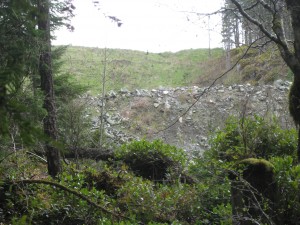 The results of these water samples, together with my observation that a significant amount of fill had over run Lot 21 and was on the neighbouring parkland, led me to subsequently ask the Minister of Energy and Mines and the Minister of Environment questions in Question Period.
The results of these water samples, together with my observation that a significant amount of fill had over run Lot 21 and was on the neighbouring parkland, led me to subsequently ask the Minister of Energy and Mines and the Minister of Environment questions in Question Period.
As background, Lot 21 is the property located at 638 Stebbings Road and is owned by 0782484 B.C. Ltd. For several years, soil has been dumped Lot 21 for later use to backfill the quarry in lot 23. A photograph of the northern boundary wall of deposited soils is shown to the left. This photograph was taken from CVRD Parkland on the north side of Shawnigan Creek.
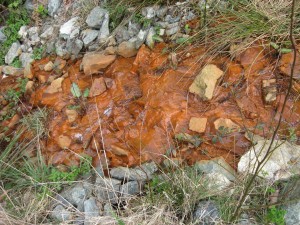 I outlined in my earlier post that it was apparent to me that substantial amounts of building materials had been placed on Lot 21. There was also clear evidence that runoff from this site failed drinking water standards at the point of entry with Shawnigan Creek. And visually, this water looked nothing like any other water in nearby surface and running water (see image to the right).
I outlined in my earlier post that it was apparent to me that substantial amounts of building materials had been placed on Lot 21. There was also clear evidence that runoff from this site failed drinking water standards at the point of entry with Shawnigan Creek. And visually, this water looked nothing like any other water in nearby surface and running water (see image to the right).
On May 15th I went back to the area to get a better sense as to what metals were contained in the orange sediments under the orange water. Since the water runoff came from Lot 21, my goal was to determine if sediments in this stream were any different from sediments at a control location upstream of Lot 21.
Four different sediment samples were obtained. Two of the samples were collected upstream of Lot 21 in order to obtain a control sample. The first, termed FLOW, in the attached data, was taken in the middle of Shawnigan Creek (see Figure 1 below). FLOW data will be used as the control sample below. The second sample (BANK in the attached data) was located at the bank of Shawnigan Creek immediately adjacent to where FLOW was collected.
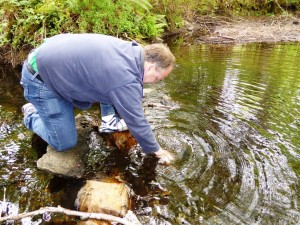
Figure 1: Photographs showing me collecting the control sediment sample in the middle of Shawnigan Creek, upstream from Lot 21.
The third and fourth samples were collected where the orange runoff entered Shawnigan Creek (Figure 2), The third, termed CREEK, in the attached data, was taken in Shawnigan Creek right at the location where the runoff enters the creek. The fourth sample was obtained about a metre upstream of the runoff stream. This is termed POOL in the attached data.
Figure 2: Photographs showing me collecting the sediment samples at the location where the Lot 21 runoff meets Shawnigan Creek (left) and in a pool a metre or so upstream of the creek in the covenant along Shawnigan Creek (right).
As in my earlier post, the metal contents in the sediments were determined using an inductively coupled plasma mass spectrometry (ICPMS). The method for the bulk analysis of acid extractable elements (that is trace elements not bound in silicate minerals) was as follows:
1) The vial was shaken to homogenize and all for the removal of an aliquot for analysis (2 mL aliquot for BANK and POOL, 10 mL aliquot for CREEK and FLOW).
2) 10 mL of 8 Molar Environmental Grade Nitric Acid was added and allowed to react overnight.
3) The sample was diluted to 50 mL with 18 mega ohm deionized water.
4) The mixture was shaken to homgenize
5) The sample was put in a centrifuge for fifteen 5 minutes at 3000 rpm to separate out any residual particulate.
All concentrations in the attached data are given in (μg/L). Since there were different amounts of sediments in the individual samples, it is not possible to directly compare their element concentrations. Rather, I will focus on what is called the enrichment factor for each element after normalization with the commonly occurring element Calcium (Ca).
By definition then, the enrichment factor of a mineral XX is:
Enrichment Factor = (XX[sample]/Ca[sample])/(XX[control]/Ca[control])
Here [sample] refers to the concentration in a collected sample (in μg/L) and [control] means the concentration in the control sample (also in μg/L).
The attached data clearly show the presence of an enriched industrial metal content of the POOL Sample.
The following elements were found to be enriched by:
Between three and four times the control values:
Magnesium (Mg), Vanadium (V), Chromium (Cr), Manganese (Mn), Cobalt (Co), Molybdenum(Mo), Caesium (Cs), Barium (Ba), Hafnium (Hf).
Between four and five times the control values:
Lithium (Li), Scandium (Sc), Germanium (Ge), Zirconium (Zr), Tin (Sn).
Between five and ten times the control values:
Niobium (Nb) [enriched 5.29 times higher than control]; Lead (Pb) [enriched 5.19 times higher than control].
Greater that ten times the control values:
Iron (Fe) [enriched 11.69 times higher than control]; Thorium (Th) [enriched 18.60 times higher than control].
After examining the elemental sediment analysis, I am left with a number of serious concerns. The enriched metal values in the sediments under the runoff leaving Lot 21 suggest that their source comes from somewhere upstream and likely within Lot 21 itself. The question I am left with is this:
What, if anything, has been buried on Lot 21 that could produce the Thorium, Lead and other heavy metal enrichment in the sediments?

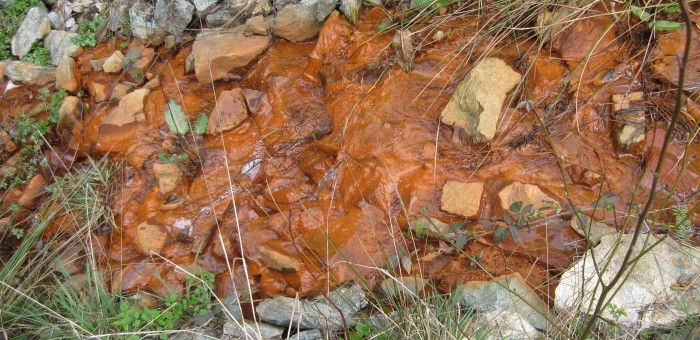
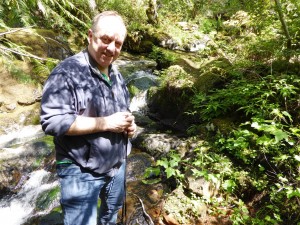
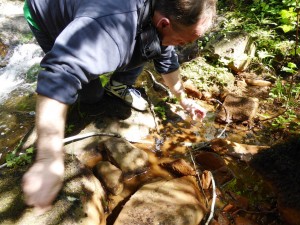



16 Comments
Andrew and Jarrod, I have sent a request to the Habitat Officers in Nanaimo to search the RARNS system to see if a RAR assessment was done on this site. I will forward the results of this search.
Thank you, Bob Crandall – Environmental C-TECH ASTTBC – QEP
Thanks. Please let me know what you find out. Andrew
Somehow I highly doubt an RAR assessment was done, or we wouldn’t be in this situation. More proof of SDM Bunce’s failure to do his duty as a representative of MOE. I hope that man does not get off Scott free in all of this.
Shawnigan Creek supports the spawning habitat for a Pacific Coho salmon conservation project, successfully operated for almost 40 years, in partnership between the Mill Bay & District Conservation Society and DFO. When “there was also clear evidence that run-off from this site failed drinking water standards at the point of entry with Shawnigan Creek”.–Coho fry and young smolts won’t survive! Just when the numbers are really starting to climb!
The highly alarming reality of this latest proof of contamination, some of which is radio active, deserves immediate attention and REMEDIATION!!
Maybe the salmon will save our watershed!
Thank you Andrew Weaver.
Not only is your initial test important it proves what I mentioned at the meeting. The provincial government has placed a facility(SIA) in harms way of decades old salmon enhancement project. The department of fisheries must act if what you are saying here is true. DFO has been standing back but must act as they have federal jurisdiction and are mandated to protecting fish.
In all of the data that has been taken by BC ministry of environment and mines there is nothing that pertains to the coho salmon of shawnigan creek. Nothing will be done to protect them. There are no plans and no assessment. How can that be so?
With low water and record temps for all streams on Vancouver Island I really hope that this issue is brought up more..While water is in important issue especially for our citizens equally important are these salmon’s survival.
Not only do the Tsawout (saanich first nations) depend on them but the hatchery in Goldstream depends on these fish. This is not just the Malahat first nations problem.
The Shawnigan Creek coho are the same genetic strain of fish for Goldstream. They can be used in the event of low returns in the Goldstream River. So you are potentially puting two streams in harms way with this project.
SIA with this project alone along with federal/provincial government will be held responsible if anything happens to those fish returns in the coming years. This facility cannot be put on a salmon enhancement creek and a water supply for thousands of residents. Hats off to you that was an excellent speech.
People should ask why is it OK to put a facility within meters to a salmon stream? And why is it Ok for dumped material that is leaking in stream OK? You can’t do it in Greater Victoria..Why up here is this different? This is an equally big issue as well as the drinking water aspect.
If you let me know your email Jarrod, I can forward you copies of letters I’ve written to DFO, BCWF and others. Hopefully they’ll step up with Andrew’s evidence of contamination threat. Otherwise 40 years of Coho conservation will have been for nothing.
ksgray@shaw.ca
Thank you for presenting your information at last night’s meeting. It did elicit an agreement from the MOE to review your findings. We need them to question the discrepancy between their findings and yours and look further for the explanation.
Thank you once again Andrew for your efforts, your diligence and your caring.
After tonight’s report from the MOE, it makes one wonder how they missed all that you found!?
Maybe because they really didn’t care enough to really look! So much for their protection for our watershed and the environment they swear an oath to protect!??
the Zirconium comes from grinding and cutting disks
https://www.airgas.com/product/Tools-%26-Hardware/Abrasives/Bonded-Abrasives/Grinding-%26-Cut-Off-Wheels/p/NOR66252809376
I suspect the Thorium is from structural welding waste materials from ship yard ship building activities
http://www.nrc.gov/about-nrc/radiation/protects-you/hppos/hppos255.html
Thorium is often used in thoriated welding rods, which are sometimes used to weld steel. This is just a guess, of course, but it is somewhat supported by data: https://en.wikipedia.org/wiki/Thorium#Non-nuclear
Niobium seems to be used in structural steel (especially in cars). I don’t know about other uses, but see here: https://en.wikipedia.org/wiki/Niobium#Applications .
Tin and lead enrichment could indicate the presence of solder. Perhaps soldered copper plumbing?
Zirconium is a really odd one. I’m not sure what to make of its presence.
Also, your numbers are right for lead and niobium,but it’s Nb and Pb, not Ng and Pd.
One other question: What are the chances that the trace element detections here, like scandium, are due to chance?
Isn’t Zirconium used in steel alloys? That seems to be the common thread through these results… Lots of metal; steel, re-bar, welds, etc.
My first thought with the elevated Thorium would be waste from recycled electronics specifically smoke and CO2 detectors. Has a natural source been ruled out? The elevated heavy metals have a bit of a VMS mineral deposit signature. Intrusion related Thorium/Uranium would have signifiant other heavy metals related to it as well. Unfortunately because of the moratorium on exploration for these metals in the Province and discovery of them would probably not been reported. Mineral may be leaching from a upstream source and could have traveled a long distance. I also question your “Blank” sample as the elevated Copper is suspicious. But if it is illegal dumping I would strongly suspect e-waste.
Thanks Tim, The Thorium and Lead really jumped out as me as it was so enriched from the control value. That control value was not far away. I cannot test on the private land, only the sediments downstream of it. The results from the sediment analysis in my view pose more questions than they do provide answers.
Thorium has never been used in smoke detectors; the isotope used there is Americium-241, which is in the Neptunium series decay chain: https://en.wikipedia.org/wiki/Decay_chain#Neptunium_series
Thorium occurs there, but there are many isotopes with longer half-lives in that chain, so the amounts that would be present would be miniscule.
I’m not aware of any CO/CO2 detectors that use radioactive isotopes.
Hello Tim, I asked about the elevated copper in the “Blank” sample which is regular tap water. It comes from copper plumbing in the building where the tap water is.